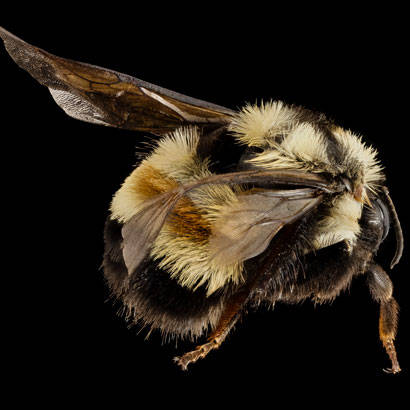
Bumblebees are some of the most unusual and endearing creatures in nature. They are large and fuzzy with tiny wings in proportion to their body size, and, until very recently, many people believed that bumblebees shouldn’t even be able to fly — they violated the rules of physics!
In seeking the reasons how bumblebees are able to fly, the explanations quickly turn toward aerodynamic flow terms such as “dynamic stall” and “leading edge vortex.” It makes you wonder if bumblebees only knew how much of a puzzle they still are to scientists and engineers.
But, bumblebees and other native wild bees are in real trouble throughout the United States. The loss of pollinating services of bees is a matter of major concern in areas dependent on certain types of crops, fruits and nuts. The rusty patched bumblebee, Bombus affinis, is one of those bee species so endangered that it was approved for listing as a federally endangered species under the Endangered Species Act.
Precipitous Decline
The rusty patched bumblebee is distinctive, with an all-black head and a reddish patch on the backs of workers and males. Queens, which are larger, do not have the reddish patch on their backs. Up until about 20 years ago, this wild bumblebee was a regular resident of fields, farms, parks and backyards. It was once common and even abundant throughout the Central and Eastern United States where its range extended to more than 30 states.
However, for a variety of reasons, including disease transmitted from commercially raised bumblebees, loss of critical habitat, poisoning from pesticides and the effects of climate change, the numbers and distribution of the rusty patched bumblebee have declined almost 90 percent in just this brief period. It is now found in just 14 states in disconnected populations.
While a number of factors are cited in the decline of rusty patched bumblebees, two causes stand out — the effects of certain insecticides, especially neonicotinoids, that are particularly toxic to native bees, and the use of commercially raised bumblebees that are infected with a pathogen called Nosema bombi that infects wild bees, as commercial bees are transported to orchards and farms for pollination services.
Two other larger scale factors are also likely in the decline of the rusty patched bumblebee — climate change and habitat loss. Climate change may impact the reproductive cycle of this species if pollen-bearing flowers and trees in the late season have already bloomed and are not available for new queens and males to start the cycle to begin new hives for the following year.
Meadows and Wildflowers Essential for Bee Habitat
Habitat loss has also been a significant cause in the decline of many wild bee species and may be one of the greatest threats to pollinators in certain areas. Meadows, grasslands and prairies are vital habitats for bees, certain types of songbirds and other valuable wildlife species. However, these habitats have been disappearing at an astonishing rate, as our landscape is transformed by development for homes, infrastructure, commerce, and energy.
To restore such habitats, the prescription is simple: “Shift from turf to meadows. Remove invasives, encourage a diversity of wildflowers and mow once per year to keep saplings down,” says Sam Droege, United States Geological Survey scientist and head of the national Bee Monitoring and Inventory Lab. “This will make great bumblebee habitat — and great habitat for birds and butterflies and other wildlife,” says Droege.
Habitat for wild bees doesn’t need to be large. In searching for people who have seen the fast-disappearing rusty patched bumblebees, I talked with Clarence ‘Sparky’ Sparks, a member of the board of the Friends of Patuxent, a volunteer group at the Patuxent Research Refuge, a national wildlife refuge near Laurel, Maryland. Sparky is an avid citizen scientist who has transformed his yard in Severn, Maryland, into a diversified landscape that is ideal for pollinators. He says he has planted native flowering trees and five garden beds with bee balm, asters, goldenrod, milkweed, boneset and other native plants. “I try to have a variety of plants and trees that bloom the maximum length of time throughout the season,” he says. “Originally, I planted to attract butterflies, but I found that all my landscaping for butterflies has been beneficial and attractive to bees as well.”
He has had rusty patched bumblebees in his yard. “The ‘patch’ is very distinctive. At first you think they might be carrying a lot of pollen, but up close you can tell it’s a reddish patch on their back,” he says.
First Bee to Be Listed as an Endangered Species
In January 2017, the rusty patched bumblebee became the first bee in the continental United States to be listed under the Endangered Species Act (seven have been listed in Hawaii). This action by the U.S. Fish and Wildlife Service was in response to a petition from the Xerces Society for Invertebrate Conservation.
In a breaking news update, as this issue of Parks & Recreation was going to press, the President’s Executive Order halting all federal regulations froze the listing for 60 days until March 21, 2017. For more on the implications of freezing of this ESA listing the rusty patched bumblebee, see NRPA’s Open Space blog.
Regardless of the implementation of the endangered species legislation, many fear that this species is headed toward extinction and all efforts should be made to aid in its recovery, something that parks can clearly aid in.
A variety of excellent resources on the rusty patched bumblebee can be found on the Xerces Society website.
Richard J. Dolesh is NRPA’s Vice President for Strategic Initiatives.

